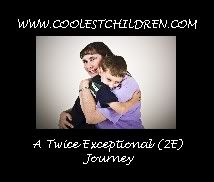The Daily Beast has a new article posted about the seeming lack of emotions in many autistic people. I wanted to post it here to let people know of this new theory. While Nathan doesn't have the emotional detach, he pulls away at times. The thing I found the most facinating stuck me about 2E kids. If a Twice Exceptional child experiences 'more' of his/her senses, why is this theory so radical? I don't agree that every Autistic/Aspie child who is detached is super-charged emotionally, but I agree we often brush off these kids when really they are so over sensitive that we don't realize it.
Enjoy the article--I know I did.
 A groundbreaking study suggests people with autism-spectrum disorders such as Asperger’s do not lack empathy—rather they feel others’ emotions too intensely to cope.
A groundbreaking study suggests people with autism-spectrum disorders such as Asperger’s do not lack empathy—rather they feel others’ emotions too intensely to cope.People with Asperger’s syndrome, a high functioning form of autism, are often stereotyped as distant loners or robotic geeks. But what if what looks like coldness to the outside world is in fact a response to being overwhelmed by emotion—an excess of empathy, not a lack of it?
This idea resonates with many people suffering from autism-spectrum disorders and their families. It also jibes with new thinking about the nature of autism called the “intense world” theory. As posited by Henry and Kamila Markram of the Swiss Federal Institute of Technology in Lausanne, suggests that the fundamental problem in autism-spectrum disorders is not a social deficiency, but rather an hypersensitivity to experience, which includes an overwhelming fear response.
“There are those who say autistic people don’t feel enough,” says Kamila Markram. “We’re saying exactly the opposite: They feel too much.” Virtually all people with ASD report various types of oversensitivity and intense fear. The Markrams argue that social difficulties of those with ASDs stem from trying to cope with a world where someone has turned the volume on all the senses and feelings up past 10. If hearing your parents’ voices while sitting in your crib felt like listening to Lou Reed’s Metal Machine Music on acid, you, too, might prefer to curl in a corner and rock. But of course, this sort of withdrawal and self-soothing behavior—repetitive movements, echoing words or actions and failing to make eye contact—interferes with normal social development. Without the experience other kids get through ordinary social interactions, children on the spectrum never learn to understand subtle signals.
Phil Schwarz, a software developer from Massachusetts, is vice president of the Asperger’s Associaton of New England and has a child with the condition.
“I think that it’s a stereotype or a misconception that folks on spectrum lack empathy,” he says. Schwarz notes that autism is not a unitary condition—“if you’ve seen one Aspie, you’ve seen one Aspie,” he says, using the colloquial term. But he adds, “I think most people with ASD feel emotional empathy and care about the welfare of others very deeply.”
So why do so many people see a lack of empathy as a defining characteristic of ASD? The problem starts with the complexity of empathy itself, which has at least two critical parts: The first is simply the ability to see the world from the perspective of another. The second is more emotional—the ability to imagine what the other is feeling and care about their pain as a result.
The fact that autistic children tend to develop the first part of empathy—which is called “theory of mind”—later than other kids was established in a classic experiment. Children are asked to watch two puppets, Sally and Anne. Sally takes a marble and places it in a basket, then leaves the stage. While she’s gone, Anne takes the marble out and puts it in a box. The children are then asked: Where will Sally look first for her marble when she returns?
Normal four year olds know that Sally didn’t see Anne move the marble, so they get it right. By 10 or 11, mentally retarded children with a verbal IQ equivalent to three-year-olds also guess correctly. But 80 percent of 10-11 year-old autistic children guess that Sally will look in the box, because they know that that’s where the marble is and they don’t realize that other people don’t share all of their knowledge.
It takes autistic children far longer than others to realize that other people have different experiences and perspectives—and the timing of this development varies greatly. Of course, if you don’t realize that others are seeing and feeling different things, you might well act less caring toward them.
But that doesn’t mean that once people with ASD do become aware of other people’s experience, they don’t care or want to connect. Schwarz says that all the autistic adults he knows over the age of 18 have a better sense of what others know than the Sally/Anne test suggests.
Schwarz notes that nonautistic people, too, “are rather lousy at understanding the inner state of minds too different from their own—but the nonautistic majority gets a free pass because if they assume that the other person's mind works like their own, they have a much better chance of being right.” Thus, when, for example, a child with Asperger’s talks incessantly about his intense interests, he isn’t deliberately dominating the conversation so much as simply failing to consider that there may be a difference between his interests and those of his peers.
In terms of the caring aspect of empathy, a lively discussion that would seem to support the Markrams’ theory appeared on the Web site for people with ASD called WrongPlanet.net, after a mother wrote in to ask whether her empathetic but socially immature daughter could possibly have Asperger’s. “If anything, I struggle with having too much empathy” one person commented. “If someone else is upset, I am upset. There were times during school when other people were misbehaving, and if the teacher scolded them, I felt like they were scolding me.”
Said another, “I am clueless when it comes to reading subtle cues, but I am *very* empathic. I can walk into a room and feel what everyone is feeling, and I think this is actually quite common in AS/autism. The problem is that it all comes in faster than I can process it.”
Studies have found that when people are overwhelmed by empathetic feelings, they tend to pull back. When someone else’s pain affects you deeply, it can be hard to reach out rather than turn away. For people with ASD, these empathetic feelings might be so intense that they withdraw in a way that appears cold or uncaring.
“These children are really not unemotional, they do want to interact, it’s just difficult for them,” says Markram, “It’s quite sad because these are quite capable people but the world is just too intense, so they have to withdraw.”
Maia Szalavitz writes about the intersection between mind, brain and society for publications like Time online, the New York Times, Elle and MSN Health. She is co-author, most recently of Lost Boy, the first memoir by a young man raised in Mormon fundamentalist polygamy, Brent Jeffs. She is senior fellow at Stats.org, a media watchdog organization.
 I contacted the web owner over there and told her about this site. I didn't know if I could be added to their blog roll or not. It's that not fitting in thing again. Here's a blog for special needs and those of us with 2E kids know full well their special needs---but do I really belong on the blog roll next to kids with terminal illness, life threatening illness or even other kids with full blown autism? I guess I get that 'red-headed step-child' feeling a lot of the time...even in cyberspace.
I contacted the web owner over there and told her about this site. I didn't know if I could be added to their blog roll or not. It's that not fitting in thing again. Here's a blog for special needs and those of us with 2E kids know full well their special needs---but do I really belong on the blog roll next to kids with terminal illness, life threatening illness or even other kids with full blown autism? I guess I get that 'red-headed step-child' feeling a lot of the time...even in cyberspace.







.jpg)